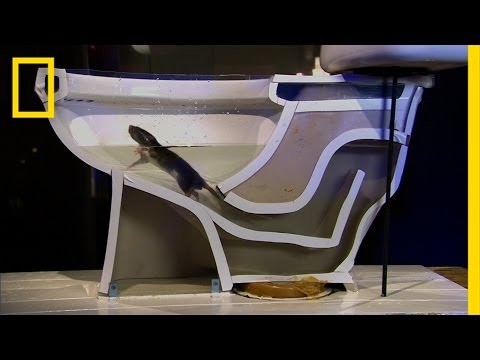Pest Lockdown
Do Rats Have Bones? How Do They Squeeze Through Tiny Holes?
A common misconception about rats is that they have no bones in their bodies. It is unclear when or where the belief started, but it seems to be rooted in their ability to squeeze through tiny holes. In truth, rats are vertebrate animals, which means they have a skeletal system comprised of a spinal cord and bones connected by cartilage. In this regard, they are not that dissimilar from humans.
So do rats have bones that bend or come apart? Some people know rats have bones but seem to think they bend or come apart at the joints in one way or another. Again, there is no truth to this assumption. Rats do not have bendable or collapsible skeletons that allow them to fit through small openings. If they did, they would be far more difficult to kill. Their bones are just like ours—rigid and attached at the joints by cartilage.
Yes, rats do have bones. Despite what some may believe, rats cannot bend their bones in such a way that allows them to fit through small holes. In fact, they owe their uncanny ability to their natural cylindrical shape and flexibility.

How Do They Squeeze Through Tiny Holes?
If rats have firm and inflexible bones, then how can they possibly squeeze their bodies through tiny holes? That is a question asked by many, and the answer lies in understanding their body shape. If you have ever seen a rat up close, you will notice that they have quite a long body form. Apart from that, their bodies are flexible and cylindrical in shape. This unusual composition allows them to jam their bodies all the way through small holes.
Moreover, rats are used to that kind of lifestyle. They are burrowing animals, used to running up and down tunnels all the time. They spend their whole lives going through tight and narrow spaces.
Of course, this skill does not apply to all rats. Only those with healthy bodies can squeeze through tiny holes. Rats that are on the heftier side won’t fit no matter how hard they try. When rats put on a lot of weight, it tends to concentrate around their abdominal area. This gives them a wider girth, hence, the inability to insert themselves through small holes.
How Small of a Hole Can a Rat Fit In?
When trying to rat-proof a home, it is important to consider what size your wire mesh must be. After all, rats are able to squeeze through tiny holes. If you have ever heard of a rat’s ability to fit through a hole the size of a quarter, you are not alone. It is a common thought passed around from neighbor to neighbor. However, it is not entirely true.
Yes, rats can fit through a hole the size of a quarter, which is about 0.96 inches in diameter. However, it depends on the proportions of the rat as well. Large or overweight rats are likely unable to go through a quarter-sized hole. On the other hand, small rats, especially juvenile ones, can do it with no problem at all.
If you are looking for the right size wire mesh for rat-proofing, it is considered unwise to go for one with 1” x 1” holes. This is still too big, and rats can squeeze through easily. Generally speaking, opting for a wire mesh with 1” x ½” holes is good enough. However, if you really want to be sure, a ½” x ½” wire mesh or smaller is the best way to go.

Interestingly, rats do not just rely on luck to get them through holes. They have whiskers that allow them to determine whether a hole is large enough for them to fit through. It does not take them very long to make this judgment. If you have ever seen a fleeing rat, you know this to be true. To discern whether a hole passes their size test, rats will poke their nose into it. If it is big enough, they will go straight through. If not, they will simply run to the next one and repeat the process.
Can Rats Get Stuck In Holes?
It is wholly conceivable for rats to get stuck in holes. In fact, it has happened on occasion. Rats may have elongated and flexible bodies, but that does not mean they are not prone to get stuck in holes.
Sometimes, rats will make a bad judgment on the size of the hole as they rush away. They will attempt to push themselves through it even though it is not large enough, getting stuck midway. Other times, overweight rats underestimate their own size, believing themselves to be small enough to fit.
Due to their flexibility and shape, though, rats typically get stuck for only a moment. They manage to get themselves out of the hole and into the next one in a matter of seconds. If they fail, whether due to miscalculation or some other reason, human intervention may be necessary.
How Do Rats Get into the House?
The short answer? Any way possible. Rats are opportunistic vermin, which means they will enter your house through any openings available. This includes vents and gaps in the walls. As you already know, rats can even fit through tiny holes. However, what most people do not know is that rats can hold their breath for up to 30 minutes, making pipes and plumbing viable entryways as well.
If you find yourself at the center of a rat problem, you can use rat poison or traps to take care of it. In more severe cases, an exterminator may be necessary. It is also recommended to inspect your house thoroughly. This means going through every nook and cranny to find even the smallest of openings. Pest control professionals can often help you locate problem areas.
However, a simple examination is not enough. Make sure to cover or seal all possible entryways you encounter. Do not leave doors open, and make sure your compost bin has a tight lid over it at all times. Consider installing a wire mesh as mentioned before, too. Rat-proofing your home is the first step in rat prevention. If they cannot find a way in, you will have less to worry about.
Can Rats Climb Walls?

As if the ability to squeeze through virtually any hole isn’t enough, rats can also climb walls. These rodents are resourceful creatures, using anything they can grip on to as leverage. Their grimy paws can grasp even vertical surfaces. This means concrete, stone, and brick walls are not rat-proof. On the positive side, smoother walls are safe.
If you see a rat climbing up your wall, it may not be enough to knock them off. Rats can fall from a height of 50 feet and remain unscathed [Source].
When performing an inspection, do not forget to check your roof for gaps. Rats are incredible climbers. If vertical walls prove no challenge to them, then trees are understandably much easier to scale. Rats can enter your house by climbing a tree, using overhanging branches to gain access to your roof. They can even run across telephone lines in an impressive feat of balance.
Do Rats Jump?

You can add jumping to the list of things rats can do remarkably well. Although the extent of their jumping ability varies from species to species, rats are generally good at leaping. In fact, it is a common offense mechanism in their arsenal as predators. It also comes in handy when fleeing from danger.
Brown rats are more skilled at jumping in a downward direction, though that does not mean they cannot do the opposite. These rats have been known to jump as high as 77 centimeters and over 4 feet on horizontal or downward slopes. Black rats, on the other hand, are among the best at jumping. These rats can spring from almost any surface, being able to leap over 5 feet, thanks in large part to their agility and lightweight form.
Can Rats Swim?

You have probably heard those horror stories of rats emerging from the toilet through the sewage system. While it does not happen all the time, it is entirely plausible. Not all rats can swim, but those that can are very adept at it. Some species can swim over a mile in open water. They can even tread water for a shocking three days. Brown rats, in particular, are fine swimmers. Black rats, though, are more used to traveling on dry land.
Rats have built up quite a reputation among homeowners. Their striking ability to fit through the tiniest of holes and seemingly appear out of nowhere has led to a misapprehension about their bodily makeup. Rats are comprised of rigid bones, just like any other vertebrates. They have their cylindrical shape and limberness to thank for many invasions and narrow escapes. With the addition of climbing, jumping, and swimming as skills, it’s no wonder rats are such formidable opponents in the household.
